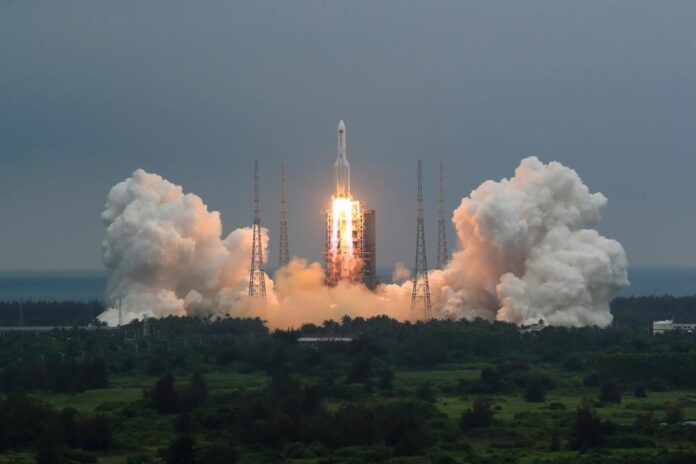Another day, another Chinese rocket body falling uncontrolled from space.
U.S. Space Command is warning that the remnants of the massive Chinese rocket that was shot into space last Sunday will likely fall to Earth soon, perhaps as early as July 31.
The 10-storey, 21-tonne rocket was part of the Wentian space station module and docked with the country’s Tiangong space station this week.
The uncrewed craft was blasted to space by a Long March 5B rocket from the Wenchang launch centre on the Chinese island of Hainan.
The big problem, however, is that experts aren’t sure how much of the rocket will survive and, most concerning, they don’t know where it’s expected to crash-land.
“It is always difficult to assess the amount of surviving mass and number of fragments without knowing the design of the object, but a reasonable ‘rule-of-thumb’ is about 20 to 40 per cent of the original dry mass,” Holger Krag, head of the Space Safety Program Office for the European Space Agency, told SpaceNews.
This is the third time China has decided not to control the disposal of the rocket body, once again putting the country under scrutiny. In both 2020 and 2021 China was responsible for similar uncontrolled falls.
Many experts believe China is taking an unnecessary risk by not tracking or controlling the fall of the massive debris.
According to Space.com, the danger to human life from a falling rocket is quite small, but the sheer size of the Long March 5B rocket makes it more of a threat.
The last time this happened, in 2021, NASA Administrator Bill Nelson said China was “failing to meet responsible standards regarding their space debris.”
Last year, remnants of a rocket harmlessly splashed into the Indian Ocean, with the bulk of its components destroyed upon reentry into the Earth’s atmosphere.
However, after the rocket’s maiden flight in May 2020, pieces of space junk fell on the Ivory Coast, causing no injuries but damaging several buildings.
Trending Stories
Woman who collected $400K in viral GoFundMe scam sentenced to prison
Transphobic response to Canmore Pride donation request sparks apology, swell of support
In the past, China has been defensive about their decision to allow the uncontrolled fall of the rocket body. According to the New York times, Hua Chunying, a senior spokesperson with China’s Ministry of Foreign Affairs, accused the United States of “hype.”
“The U.S. and a few other countries have been hyping up the landing of the Chinese rocket debris over the past few days,” Ms. Hua said.
“To date, no damage by the landing debris has been reported. I’ve seen reports that since the launch of the first man-made satellite over 60 years ago, not a single incident has occurred where a piece of debris hit someone. U.S. experts put the chances of that at less than one in a billion,” she told the outlet last year.
The rocket body’s flight path is hard to predict because of fluctuations in the atmosphere caused by changes in solar activity.
Experts say this time around, a few tonnes of metal could fall anywhere along the booster’s orbital path, which travels as far north as 41.5 degrees north latitude and as far south as 41.5 degrees south latitude.
In other words, major cities like New York, Los Angeles, Cairo and Sydney, Australia all lie in the rocket’s eventual descent path. According to The Aerospace Corporation’s map, Canadian cities like Toronto also fall within the reentry range.
Ted Muelhaupt, a debris expert at Aerospace Corporation, a non-profit largely financed by the U.S. government, told the NYT that the U.S. and other countries typically will control the reentry of their space debris ” if the chances of an injury to someone on the ground are higher than 1 in 10,000.”
He added that he is “very confident this is above the threshold. Well above the threshold.”
To date, there have be no known cases of personal injury caused by falling human-made space junk.
© 2022 Global News, a division of Corus Entertainment Inc.



